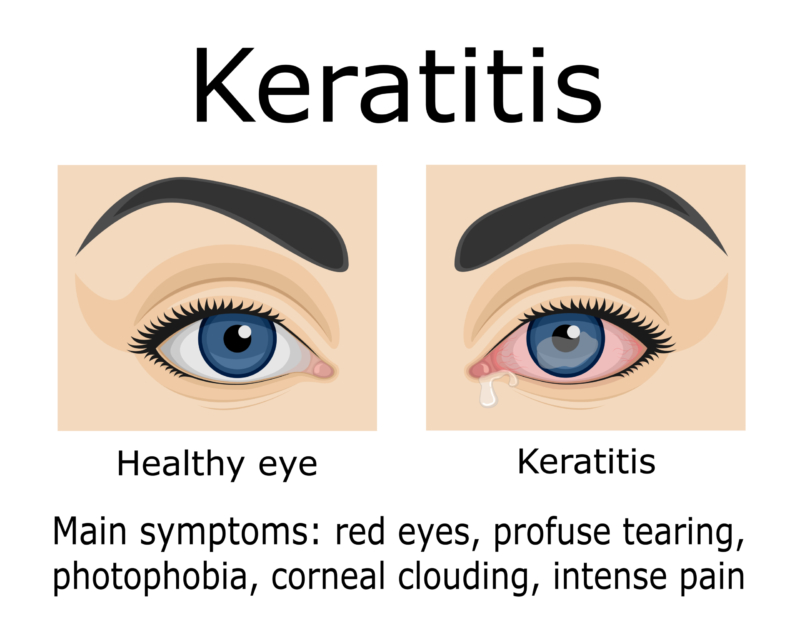Keratitis, also referred to as a corneal ulcer, is an inflammation or irritation of the cornea. There are two types of keratitis: infectious and noninfectious. Both are treatable and manageable if caught early. However, if left unchecked and untreated they can lead to vision loss.
Infectious Keratitis Causes
Keratitis that occurs as a result of an infection is called infectious keratitis. It is common in contact lens wearers who do not practice proper lens hygiene and maintenance. In other cases, it can be brought on by a viral infection like shingles or the common cold.
- Bacterial infection. Bacteria and fungi can live on the surface of the contact lens or in the lens case, especially if neither is properly cleaned and maintained. Bacterial infection-related keratitis is common in patients using extended-wear lenses.
- Viral infection. The viruses that cause the common cold and shingles (varicella virus) can also cause corneal ulcers. The virus that causes cold sores (herpes simplex) can lead to repeated infectious keratitis when the patient is triggered by stress or exposure to sunlight.
Noninfectious Keratitis Causes
Noninfectious keratitis occurs as a result of abrasions to the cornea. In some cases, it can be caused by eyelid disorders, dry eyes, or an injury.
- Eyelid disorders. Certain eyelid disorders like entropion or ectropion, which prevent the eyelid from properly functioning, can lead to corneal ulcers.
- Dry eyes. Patients who suffer from dry eye syndrome may also suffer from keratitis. Their eyes do not have proper lubrication to wash, soothe and protect the eye, a corneal ulcer could develop.
- Injury. Corneal abrasions like scratches or scrapes from fingernails, tree branches, and makeup brushes, can result in noninfectious keratitis. In some cases, these injuries can cause an increased risk of infectious keratitis if not quickly treated.
Symptoms for both types of keratitis are similar:
- Feeling that something is in your eye
- Blurred or impaired vision
- Eye pain or discomfort
- Excess tears or discharge from the eye
- Redness
- Sensitivity to light

Keratitis Treatments
During an eye exam, the ophthalmologist will use a fluorescein dye to determine if there is a corneal ulcer and assess any corneal damage. They might take a tissue sample to examine for the best treatment options. Infectious keratitis is treated with antibiotic eye drops. In severe cases, an oral antibiotic might be prescribed. Noninfectious keratitis is treated with artificial tears, but in severe cases, an ophthalmologist might prescribe anti-inflammatory antibiotic eyedrops.
If you are currently suffering from symptoms related to keratitis, it’s important to see an ophthalmologist for diagnosis and treatment. With prompt attention, keratitis is typically treated without vision loss. Dr. De Castro is a board-certified ophthalmologist who specializes in the cornea. Contact our office at 954-741-5555 to schedule a consultation.






